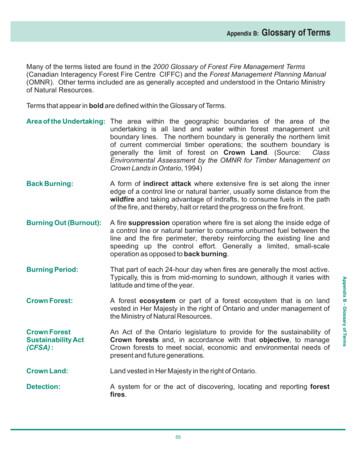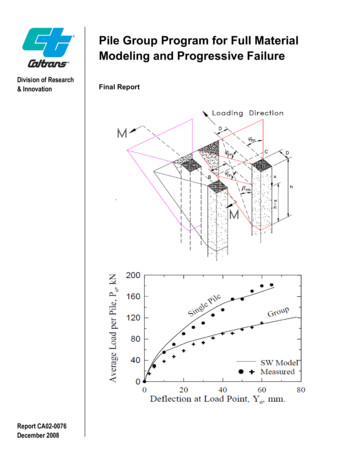Fire Department COVID Response Mobile Decontamination .
Fire Department COVID ResponseMobile Decontamination Module (CRM) GuideTo assist in this year’s fire season response to the COVID Pandemic localgovernment fire departments can assist in the containment of the virus bybuilding a mobile decontamination unit or COVID Response Module (CRM).These units will be used to decontaminate fire vehicles and equipment onwildland fire incidents.Many local volunteer, county and municipal fire departments already have theequipment necessary to “build” a mobile CRM.Following is information that will assist you and your departmentin building a Mobile CRM.Please contact your local New Mexico State Forestry District Officewith further questions and assistance. CRM Decon Units will be required to wear PPE and change outregularly (the sending agency will provide adequate supplieswith the resource) All COVID -19 Precautions including Social Distancing is arequirement while decontaminating equipment and vehicles andwhile assigned to the incident.
The goal is to deliver a CDC Approved COVID-19 disinfectant, with a FINE MISTat a sustainable 35 PSI for a complete vehicle (inside/outside), equipment,on “high touch” surfaces and other sites as needed.Equipment Needed for Compressed Air System to generate a sustainable 35 psi:System 1Generator/Compressor SystemPortable generator20 - gallon air compressor with in-line filtersAir nose with quick connectorsPaint “can” type sprayer, regulator built in preferable.35 psi must be sustained to produce a fine mist of disinfectant.System 2Self Contained Breathing Apparatus (SCBA) SystemSCBA Bottles ( Spray time will vary with tank capacity)SCBA Harness or back- back“Buddy Breathing quick connect” on the LOW pressure side“Quick connect” connectors for air hosePaint spray can (with built in regulator is preferred)Access to a mobile SCBA refill system or compressor(Approximately 1.5 bottles may be required to DECON 1 vehicle)Hand – pump or garden type sprayer’s can be used for portability in some situations.This is not recommended for primary use.Photo illustrating SCBA Compressed Air Systemin use. Remember that all operators are requiredto wear ALL PPE during decontaminationprocess: head wear, eye protection, face masks,gloves, disposable gown or body coverings.
APPROVED DISINFECTANTS & USENEW MEXICO STATE FORESTRY- DISINFECTANT DECONTAMINATION ANDSPRAYER APPLICATION INSTRUCTIONSThe disinfectant sprayer can be used anytime that a Command Vehicle, Engine or Crew Carrier needs tobe cleaned, not just after a suspected COVID-19 contamination. Whether you are using the preparedsolution created by Kosher salt, commercially available disinfectant tablets or a bleach (sodiumhypochlorite) product, the spray application is similar. The average shelf life once prepared isapproximately three (3) days so date tagging the solution container is critical. Any solution after threedays should be disposed of.Solution Preparations:Ecolox Tech’s Electrolyzed Water SystemGenerates hypochlorous acid (HOCl) with an ORP between 800 and 1000(setting 3). “Setting 3 is the preferred cycle for disinfectant purposes.”Instructions for Generate Hypochlorous Acid (HOCl) Cleaner & Disinfectant1. Add tap water (or purified water) up to the 1 Liter mark2. Using 1 gram measuring spoon, add 1 gram Kosher salt per 1/2 Liter of water *3. Add 1 tsp. of distilled white vinegar** (5%) (Optional but recommended to optimize pH)4. Place lid and plug-in the power supply ***5. Press to Power On Press once for Setting 1
Setting 1 – System runs for 3 minutes Filled to 1 Liter mark – generates 40 ppm * Use only foodgrade salt (NaCl). It is recommended to use Kosher salt only since it contains no iodine.Press twice for Setting 2Setting 2 – System runs for 5 minutes Filled to 1 Liter mark – generates 60 ppm (for sanitizingfruits and vegetables)Press three times for Setting 3Setting 3 – System runs for 8 minutes Filled to 1 Liter mark – generates 100 ppm Filledto 0.5 Liter mark – generates 200 ppm** Adding vinegar will lower pH therefore allowing hypochlorous acid (HOCl) to be the dominant freechlorine molecule. *** Power supply must be dry.The CDC recognizes electrolyzed water, also called "superoxidized water", and the microbiocidal activityof hypochlorous acid (HOCl) in its guidelines for disinfection and sterilization in healthcare facilities.FDA cleared per Food Contract Notification #1811 and USDA Organic.Defense Soap Defense Disinfectant TabletsDefense Soap’s disinfectant tablets are a safe, EPA-registered bleach alternative ineffervescent tablet form. Using the power of hypochlorous acid, our disinfectantis effective against a broad range of microorganisms which includes C. difficilespores, Hepatitis B, and Norovirus. The single dose tablet delivers accurate strength solution every time, eliminating the need tomeasure and pour guesswork.Simply drop 1-2 large tablets into a sprayer for every gallon of water used or 1-2 small tabletsinto a sprayer for every quart.One gallon covers about 6,000 square feet (about four wrestling mats). If not using anelectrostatic sprayer, dispense disinfectant with a pump sprayer and spread evenly with amicrofiber mop. The disinfectant must remain on the mats 4-10 minutes (depending on strengthof solution) to achieve the maximum kill of microorganisms.Defense Soap’s disinfectant tablets are a safe, EPA-registered bleach alternative in effervescent tabletform. Using the power of hypochlorous acid, our disinfectant is effective against a broad range ofmicroorganisms which includes C. difficile spores, Hepatitis B, and Norovirus.Defense Soap’s Disinfectant Tablets recently made the EPA’s list of approved antimicrobial productsfor use against Novel Coronavirus SARS-CoV-2, the Cause of COVID-19*
Sodium Hypochlorite (Bleach)Over the Counter Bleach, Full Strength and Non-diluted Recommend use of EPA-registered household disinfectantexternal icon.Follow the instructions on the label to ensure safe and effective use of theproduct. Many products recommend:Keeping surface wet for a period of time (see product label)Precautions such as wearing gloves and making sure you have good ventilation duringuse of the product. Diluted household bleach solutions may also be used if appropriate for thesurface.Check the label to see if your bleach is intended for disinfection, and ensure the productis not past its expiration date. Some bleaches, such as those designed for safe use oncolored clothing or for whitening may not be suitable for disinfection.Unexpired household bleach will be effective against coronaviruses when properlydiluted.Follow manufacturer’s instructions for application and proper ventilation. Never mixhousehold bleach with ammonia or any other cleanser.Leave solution on the surface for at least 1 minute.APPLICATION PROCEDURES: Pour pre-mixed disinfectant from storage bottle (check date to ensure that thecreated date is no greater than 3 days old) into the reservoir on the sprayer. One fullreservoir is enough solution to spray a vehicle inside and out with a fine mist.Assure that an in-line filter is attached before the hose connection to prevent anycontamination of the hose line and sprayer. Routine cleaning of the filter is highlyrecommended.
Adjust the sprayer’s in-line regulator to approximately 35 psi. This psi has beendetermined to distribute the appropriate amount and pattern desired for this product.Be aware that it is difficult to get this number exact, so get as close as you can.Don mask, eye protection and gloves. While the disinfectant is non-toxic and safe forskin contact, we will be wearing PPE while aerosolizing to protect from any airway oreye irritation.Begin spraying the interior of the cab area first. While spraying, keep in mind that ourgoal is to have a contact time of 4-10 minutes. That means we want the disinfectant tostay in contact with the surface for as close to 4-10 minutes before drying. Therefore,we don’t want to spray too little and have it dry too quickly, or spray too heavily andpool unnecessarily. Once spraying is complete, the doors can remain open for fasterdrying.Spraying can now commence on spraying any compartments and then closing thosedoors. Now finish spraying the external areas of the vehicle that have receivedpotential contact.After 4-10 minutes has passed, open the doors. Wipe any excess disinfectant that hasstill not dried. There will also be a slight film on any glass that was sprayed, so pleasewipe down with glass cleaner.Hand clean any area that you might think need some extra attention, such as doorhandles, radio microphone and steering wheel.After all spraying is complete, run clean water through the sprayer to flush paint potand nozzle.**Please use common sense when working the sprayer around electronics. Excess liquid of anykind can easily damage them, so keep the mist light or clean by hand.**The above excerpt is directly from the CDC’s vent-getting-sick/disinfectingyour-home.htmlLinks to assist:https://www.ecoloxtech.com/ecoone/Rio Rancho FD Decon Video
Mobile Decontamination Module (CRM) Guide . To assist in this year’s fire season response to the COVID Pandemic local government fire departments can assist in the containment of the virus by building a mobile decontamination unit or COVID Response Module (CRM). These units will be used to decontaminate fire vehicles and equipment on
FIRE TOPPER Fire Bowl User Manual Home » FIRE TOPPER » FIRE TOPPER Fire Bowl User Manual Contents [ hide 1 FIRE TOPPER Fire Bowl 2 Setting Up Your Fire Topper Fire Bowl 2.1 Set-Up 3 Placement and Location 3.1 Liquid Propane Tank 4 Using your Fire Topper Fire Bowl - For your safety, read before lighting. 5 Cleaning, Maintenance, Storage 6 .
Colerain Fire Department 360.00 Belmont Vol. Fire Department 480.00 Lafferty Vol. Fire Department 1,080.00 Somerton Vol. Fire Department 1,080.00 Powhatan Point Vol. Fire Department 480.00 Bellaire Volunteer Fire Department 720.00 Brown Higginsport Vol. Fire & EMS 1,080.00 Mt. Orab Fire Department 1,440.00
Florez Jennifer 166204283 3/14/2022 Denver Fire Department Denver Fire Department Fire Inspector II Florez Joseph 196209071 9/29/2022 Denver Fire Department Denver Building Department Fire Inspector II Foster Joel 186607830 12/27/2021 Canon City Area Fire Protection District Canon City Area Fire Protection District Fire Suppression System Inspector
social or cultural context (livelihoods, festivals, traditional, conflict) and perhaps regulatory framework (permit fires, illegal fires). The terms include fires, wildfires, wildland fire, forest fire, grass fire, scrub fire, brush fire, bush fire, veldt fire, rural fire, vegetation fire and so on (IUFRO 2018). The European Forest Fire
Fire Exit Legend Basement N Blood Fitness & Dance Center Fire Safety Plans 7.18.13 Annunciator Panel Sprinkler Room AP SR FIRE FIRE SR ELEV. Evacuation Route Stair Evacuation Route Fire Extinguisher Fire Alarm FIRE Pull Station Emergency Fire Exit Legend Level 1 N Blood Fitness & Dance Center Fire Safety Pl
Squirrel threw the fire to Chipmunk. The Fire Beings ran after the fire. One Fire Being grabbed Chipmunk’s back. The Fire Being’s hot hand put three stripes on Chipmunk’s back. Chipmunk threw the fire to Frog. The Fire Beings ran after the fire. One Fire Being grabbed Frog’s tail. Frog jumped, and
Appendix B: Glossary of Terms A p p e n d i x B-G l o s s a r y o f T e r m s Fire Depletion Area Burned: Fire Impacts: Fire Intensity: Fire Load: Fire Management: Fire Management Zone: Fire Prevention: Fire Protection: Fire Regime: Fire Risk: Area burned that directly impacts wood supply to the forest industry. This could include allocated .
pile bending stiffness, the modulus of subgrade reaction (i.e. the py curve) assessed based on the SW model is a function of the pile bending - stiffness. In addition, the ultimate value of soil-pile reaction on the py curve is governed by either the flow around failure of soil or the plastic hinge - formation in the pile. The SW model analysis for a pile group has been modified in this study .























